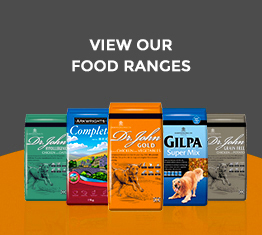Advice & Feeding Guides
Good advice on feeding dogs can come from a range of different places, experienced vets, trainers, breeders and reputable websites. It is always worth considering the bias of these sources and doing your own research to establish where opinion may be overstating scientifically proven fact.
These guides are designed to help with understanding the different requirements that your dog may have compared to normal adult maintenance. This may be because your dog is a growing pup or a high performance dog or alternatively they may be an elderly senior. For more specialised advice on your particular dog please contact us directly.
HOW MUCH FEED
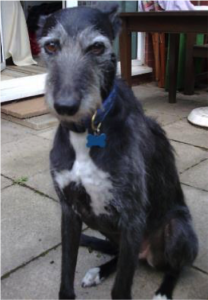 All dogs will vary in their nutritional requirements, and although estimates can be made for average breed size, individuals may require more or less than these guidelines. Factors to consider are whether your dog is smaller or larger than the standard for the breed, how active they are, their energy levels, their age and appetite. Then, start with the recommended feeding amount and adjust to as many of these factors as possible – never going more than 50% over or under the starting amount (exceptions for puppies and during breeding). Always remember to subtract a small amount for treats if using these as behavioural rewards. The resulting amount is your starting point. Immediate signs of overfeeding are struggling to finish the food in one sitting and loose stools or diarrhoea; a more long term effect is weight gain. If you under feed, some obvious signs are that your dog will be ravenously hungry and constantly asking for food even after finishing the meal and in the longer term, weight loss will result. Weigh your dog regularly and keep a careful eye on their shape to maintain a good level of condition. You should see a nice covering on your dog but the ribs should be felt once you press lightly. How you measure the food is important, the best way is to weigh the food out each time as this avoids inaccuracies gradually being built up over time. Alternatively a measuring cup or marked scoop can be used, but with this method it is worth weighing out the amount you are measuring every now and again, to make sure that the amount still matches the weight you are expecting.
All dogs will vary in their nutritional requirements, and although estimates can be made for average breed size, individuals may require more or less than these guidelines. Factors to consider are whether your dog is smaller or larger than the standard for the breed, how active they are, their energy levels, their age and appetite. Then, start with the recommended feeding amount and adjust to as many of these factors as possible – never going more than 50% over or under the starting amount (exceptions for puppies and during breeding). Always remember to subtract a small amount for treats if using these as behavioural rewards. The resulting amount is your starting point. Immediate signs of overfeeding are struggling to finish the food in one sitting and loose stools or diarrhoea; a more long term effect is weight gain. If you under feed, some obvious signs are that your dog will be ravenously hungry and constantly asking for food even after finishing the meal and in the longer term, weight loss will result. Weigh your dog regularly and keep a careful eye on their shape to maintain a good level of condition. You should see a nice covering on your dog but the ribs should be felt once you press lightly. How you measure the food is important, the best way is to weigh the food out each time as this avoids inaccuracies gradually being built up over time. Alternatively a measuring cup or marked scoop can be used, but with this method it is worth weighing out the amount you are measuring every now and again, to make sure that the amount still matches the weight you are expecting.
NEW PUPPY?
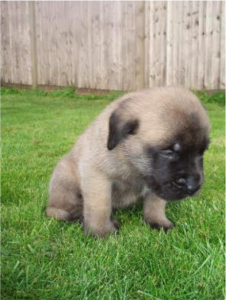 Puppies are gorgeous balls of fluff that tug at your heart strings no matter your age or circumstance. But if you are seriously considering getting a puppy, there is a lot to think about.
Puppies are gorgeous balls of fluff that tug at your heart strings no matter your age or circumstance. But if you are seriously considering getting a puppy, there is a lot to think about.
to start with:
- Commitment to 10+ years of your life to looking after your dog through all his/her life stages. Commitment to regular exercise, playtime, providing a suitable diet and veterinary care as needed.
- Providing a suitable environment for a dog, a warm quiet place for them to sleep, room to play and a fenced in, secure garden that they can treat as their own.
- Possible a second dog? Some breeds don’t cope well on their own and need a pack to feel secure.
- Destruction. All dogs at some point in their lives will mistake your special things for theirs, and personalise them.
Then the tricky question of why a puppy, when there are so many older rescue dogs that are in need of a home. Older dogs have a lot of benefits, they are house trained, will often respond to simple commands and will be desperate to please you and keep their new home. If it is your first dog, and you are contemplating a rescue, this needs to be approached carefully as some dogs need extra care and may need restrictions like no cats, wearing muzzles outside etc. A good rescue centre will help you decide on a suitable dog, they want a forever home for whichever dog you choose so will work to find the right one for you.
If you still decide on buying a puppy, then researching into the right breed to suit your lifestyle is essential, as different breeds can differ in terms of character, behaviour, activity, work and intelligence, for instance, a working spaniel is an ideal high drive active working dog, whilst a Labrador (from the non-working stock) would make a perfect family pet.
PUPPY DEVELOPMENT
>0 weeks
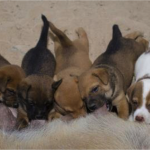 All puppies will develop slightly differently to each other depending on their environment and genetics but they all will go through the same stages during the first 12 weeks from birth.
All puppies will develop slightly differently to each other depending on their environment and genetics but they all will go through the same stages during the first 12 weeks from birth.
Puppies develop quickly from birth. At first they are blind and deaf and reliant on their mother for warmth. They are tiny in terms of size and weight when they are born. Yet, in the first week most puppies will double or triple their birth weight. Rate of puppy development also varies from breed to breed. For instance, Cocker spaniel puppies open their eyes sooner than Fox terrier puppies, whilst Basenji puppies will develop teeth earlier than Shetland sheep dog puppies.
0-2 weeks
During the first 2 weeks of life, puppies will sleep 90% of the time and spend the majority of the time when awake nursing. It’s important that they get the first milk that their mother produces (called colostrum) as it is rich in antibodies that will support their immune system and help protect against disease. They grow very quickly during this period and will soon be trying to crawl by making paddling movements with their front legs. This movement will help to develop their muscles and coordination so they will quickly learn how to move effectively and will start to crawl all over and around each other and their mother. Although they still can’t see or hear, their sense of smell and touch helps them to find their mother when needed.
2-4 weeks
At some point between week 2 and 4 the puppies will open their eyes and ears, and begin to understand their world, although it is not until week 5 that they can see and hear fully. It’s thought that this is the time when they will imprint and understand what species they are. They begin to vocalise and become more agile as they learn to stand, sit and start to walk by week 3. They will gradually learn to play and become more independent from their mother.
4-8 weeks
By week 4 to 10 they begin socialising. They interact with each other more and more and start to form attachments. It’s also an important time for them to meet and become familiar with humans. Milk production slows from the mother and their baby teeth erupt so weaning begins, typically onto a young puppy food which is provided in a soft wet form. By week 5-6 their baby teeth are completely in.
8-12 weeks
Weaning will normally end by week 8. At this point the puppies will often go through a fear period where they react fearfully to new people and objects, so it is important to keep them from being over stimulated during this phase.
12 weeks +
After 12 weeks puppies will continue to grow quickly over the rest of their growth period. In most cases small breed pups will mature earlier than large breeds, for instance, a small Terrier will complete its growth in 6 months whilst a Newfoundland will take up to 2 years to develop their adult shape.
PUPPY TIMING
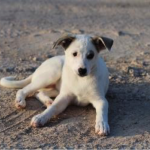 Timing with puppies is everything. Once you’ve decided to get a puppy there’s a lot to get done before bringing them home so time to plan is vital. Research into their typical behavior and needs will help, and if you are getting your pup from a recognized breeder this is the ideal place to start.
Timing with puppies is everything. Once you’ve decided to get a puppy there’s a lot to get done before bringing them home so time to plan is vital. Research into their typical behavior and needs will help, and if you are getting your pup from a recognized breeder this is the ideal place to start.
Most experienced dog owners would agree that spring or summer are the best seasons to bring a puppy into your household. Puppies are mostly born in the spring anyway – as with most baby animals, nature has decided that this is a good time! Plus these are ideal months because it doesn’t rain as much which is important for house training, and both you and the pup will naturally enjoy walks and outings more in good weather.
The best age to bring a puppy into a new household is between 7-12 weeks. At this point they are becoming independent from their mother and are ready to form an attachment with a new owner. Typically 8-10 weeks of age is the best age to come home, but it needs to be a good time in your diary too when you can be at home and give the new addition all your attention.
WHAT YOU NEED FOR A NEW PUPPY
 At home:
At home:
Designate areas that your puppy will be allowed in and remove dangerous items (electrical, loose leads etc.) from their potential reach. Plan a quiet area that your puppy will have exclusively. A crate can be used, but again find a quiet place where it doesn’t need to be moved regularly. Plan to feed your puppy in this area too, so it becomes a place quickly associated with food.
Decide in advance whether your dog will be allowed upstairs and how to discourage any explorations or the puppy from simply following you up. Baby gates can be a good temporary solution to open stairs. Puppies are not able to manage stairs so will need carrying until you can teach them how to safely crawl up and down.
What to buy:
Beds and Crates: When buying a crate it is important to get this big enough for when your puppy is fully grown. Well-made crates will have plastic trays in the bottom which are easy to clean and no sharp edges to harm your puppy. Buying a cover for the crate is also a good way to make it a warm safe environment but ensure there are big gaps between the crate and cover allowing for ventilation.
Veterinary bedding is ideal for puppies. It washes well and comes out nearly dry so can be put back nearly straight away, it is also soft on their skin and warm.
Food and water bowls: These need to be heavy bottomed dishes to ensure they don’t tip over & made of material that cannot be chewed. Puppy sized versions are available which will allow easier access for small puppies.
Identification tag: The Control of Dogs Act (1992) states that these should include the name and address of the owner. It is optional to include a telephone number but is recommended as it will speed up the process of reuniting a lost pet.
Collar: This should be a light weight type that fits well now. There are fabric versions with extensions which would last most of the growth period. There should be room to easily move the collar around but not to come over the head when tugged lightly.
Lead: Again you will only need a light weight mid length lead to start with. Make your puppy comfortable with the lead before trying a short walk and always try to lure your puppy along rather than pull.
Food: A good breeder will send your puppy home with enough food for a few days, but it can be worth enquiring before what food it is and getting a small bag in to cover the first few weeks before moving onto a suitable puppy diet.
Toys and Comforters: Teething toys are a good idea as well as chew treat toys (where you can hide treats inside them) which can occupy your puppy’s attention and teeth. A pet comforter is a nice addition to provide warmth and security for your puppy when sleepy.
Newspaper/training pads. These can help with house training your puppy at the start and catching any accidents inside. Also very useful for visits to new environments/households where you want to introduce your puppy.
Pet insurance: Many puppies will come from a breeder with a week or two of insurance cover but it is important to arrange a new policy yourself as soon as possible. Lifetime insurance may be worthwhile considering, as some 12 month policies will exclude conditions for which a claim has been made when the policy comes up for renewal.
Vaccinations, micro chipping and worming: The normal vaccination schedule for puppies is vaccinations at 7-8 weeks of age and the second set following 2 weeks later at 9-10 weeks of age. This is then followed by annual boosters or blood tests indicating which inoculations are needed. Good breeders will sort out the first set and give you the record to take along to your vet when you first register your new dog. Most breeders will also microchip your puppy and give you the registration details which again your vet will need to check. The vet will conduct a general examination of your puppy and offer advice on diet, weight and a flea and worming schedule for your puppy.
BRINGING YOUR PUPPY HOME
 Plan to bring your new puppy home during a quiet week, when you will be at home. If you have children they will love to help to start with, so if it’s half term or holiday time all the better. Remember you will need to establish a routine as soon as possible that works for you and the pup, and this will help him/her to settle in quickly and learn what is expected.
Plan to bring your new puppy home during a quiet week, when you will be at home. If you have children they will love to help to start with, so if it’s half term or holiday time all the better. Remember you will need to establish a routine as soon as possible that works for you and the pup, and this will help him/her to settle in quickly and learn what is expected.
When bringing your puppy home for the first time, plan the journey carefully, the loud unfamiliar noises of trains, buses and busy areas will scare your puppy so avoid these if possible. If you are driving there, have a passenger so they can check on the puppy during the journey and keep them reassured. Travel crates are a good idea to keep your puppy in a safe contained area in the car, also bring spare towels for accidents and schedule a break half way in the journey with a water stop if the journey is over an hour. Don’t worry too much if your puppy is sick during the journey, travel sickness is quite common in puppies but they normally grow out of it. If your puppy continues to be sick at home then you may need veterinary advice.
Plan to spend the whole day with your puppy so arrive at the breeder’s home as early as possible so you have time to go through all the documents, information on your puppy’s current routine and what your puppy will need over the next few days. This will also allow your puppy to become more familiar with you before leaving.
Once you are home, allow the puppy to stretch its legs in the garden and then introduce your puppy to the areas of your home they will be in and any new family members and pets. It’s best to start with an activity routine immediately, although, remember that puppies don’t need walks like an adult dog does and over-walking will excessively tire a puppy and can cause some harm to developing joints. Simply exploring the garden and little games with you will be enough to start with.
Garden Time: Typically puppies need to go out into the garden frequently. This needs to be first thing in the morning, after every meal, after a long sleep and any time when they look as though they might need to! You will need to go out there too, create a command that you can remember each time to say in a gentle firm tone and then praise them when they perform. To start with, reward them with a small treat (or biscuit from their diet) so they identify your praise with rewards too. All pups will have accidents along the way but so long as their bedding is washable and they are in areas that can be easily cleaned, these are easily dealt with and ignored, reinforcing praise and rewards for good behavior.
Sleeping: Puppies need to sleep a lot, and will nap anywhere so long as it is quiet and warm. Try to encourage a rest after eating to encourage good digestion. For the first couple of nights you will probably need to check on your puppy during the night and take them outside if needed. Be patient with your puppy during this time, but make it a short trip outside then back to bed.
Training: This needs to start straight away at home. Introduce consistent commands and reward methods early on to ensure a good start. Training classes can be a great way to meet people with similar issues and also for your puppy to socialize in a safe environment. However it is important to wait until vaccinations are complete and it is not until a further 7 days after the second set that your puppy will be safe to go outside and meet other dogs.
PUPPY FEEDING SCHEDULE
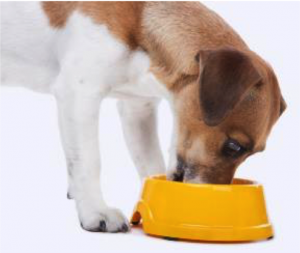 What you feed your puppy is even more important than with an adult dog as this is the key stage for determining their adult health and wellbeing. First of all, they need to be fed a puppy diet and a complete dry food will ensure they get all the nutrients and bone minerals in the right percentages to match their growth.
What you feed your puppy is even more important than with an adult dog as this is the key stage for determining their adult health and wellbeing. First of all, they need to be fed a puppy diet and a complete dry food will ensure they get all the nutrients and bone minerals in the right percentages to match their growth.
They need to be fed little and often. At the weaning stage the food needs to be soaked and then broken into small pieces (a food processor is ideal) before putting into a wide shallow dish for the puppies to investigate. Try smearing a small amount on the puppies’ lips to get them interested in eating but allow them to find the food on their own. By the time they reach 8 weeks of age they will be on 4-5 meals a day. Don’t worry if there is food left in the bowl at the end of meal time, a puppy’s stomach is very small which is why they need food so often at this stage. Monitor their stools as a puppy’s stools may well be less formed than an adult, but there should be some formation to them, if not try cutting back on their diet a little. If they seem to always be hungry, finish every bowl of food, shiver or seem a bit lethargic they may need more food than you are putting down.
In the first few weeks of bringing your puppy home, try not to feed too many different types of food or treats. This way you can establish a base line for what suits your puppy’s digestion, introduce puppy treats in small quantities and only as rewards for good behaviour. Bones and chews are a good idea but make certain your puppy is chewing them appropriately and they don’t splinter or breakdown in the mouth easily.
As the puppy grows up the number of meals decrease (from 4 to 3 and finally to 2) and the amount of food gradually increases. Follow the feeding guidelines on the pack carefully as overfeeding can cause too much weight gain on an immature frame. For most growing dogs, there are three main dietary changes, feeding first a puppy diet from weaning to half adult size(we recommend Dr. John Puppy), then a Junior/Adolescent diet until the growth period is complete(we recommend Dr. John Titanium or Dr. John Puppy) and finally an adult diet once growth is complete.
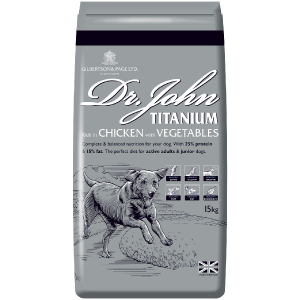
It is important that your puppy also has access to fresh water, ideally refresh this daily and replenish as needed. Puppies fed a dry biscuit diet will naturally drink more water than those fed on fresh or canned meat. Keep an eye on your puppy’s weight through regular visits to your vet’s surgery or at home. The simplest method is to weigh yourself on a pair of bathroom scales and then weigh yourself again whilst holding your puppy, then just subtract your weight from the second reading.
LARGE & GIANT BREED PUPPIES
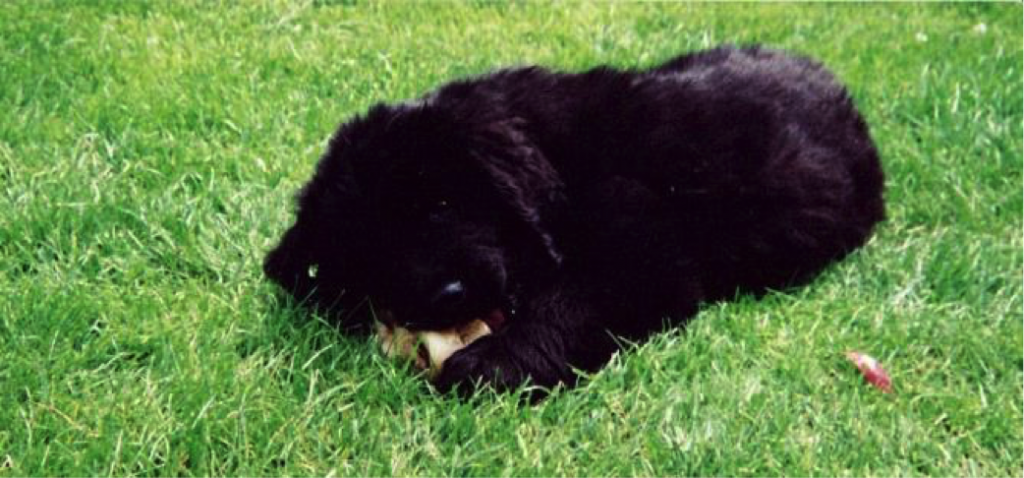 Large & giant breed puppies will need to be fed a growth diet for much longer than a toy or small breeds, whilst a terrier pup will finish its growth by 6 months of age, a giant breed like a Newfoundland will still be growing at 18 months. It’s particularly important that growth in these larger dogs is evenly spread over this period and the nutrient levels are appropriate. Our growth diets, as with all our diets, require no supplementation as they are complete foods with all the nutrients, vitamins and minerals needed for growth in the right proportions. In fact supplementing with additional minerals or vitamins can create a nutrient imbalance which can affect coat, appetite and even bones. There is some evidence to suggest mineral imbalance can cause bones to become enlarged yet with lower bone density which could have detrimental consequences in later life (osteochondrosis, osteoarthritis).
Large & giant breed puppies will need to be fed a growth diet for much longer than a toy or small breeds, whilst a terrier pup will finish its growth by 6 months of age, a giant breed like a Newfoundland will still be growing at 18 months. It’s particularly important that growth in these larger dogs is evenly spread over this period and the nutrient levels are appropriate. Our growth diets, as with all our diets, require no supplementation as they are complete foods with all the nutrients, vitamins and minerals needed for growth in the right proportions. In fact supplementing with additional minerals or vitamins can create a nutrient imbalance which can affect coat, appetite and even bones. There is some evidence to suggest mineral imbalance can cause bones to become enlarged yet with lower bone density which could have detrimental consequences in later life (osteochondrosis, osteoarthritis).
WHY CAN’T I FEED MY PUPPY ADULT FOOD?
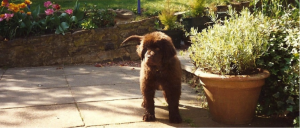 Puppies have different requirements to adult dogs. During their growth period they need higher levels of energy, protein, fat and certain minerals and vitamins to maintain their optimum growth. To feed a puppy on an adult diet would mean doubling the amount of food you would need to give the puppy. This would be difficult to interest the puppy into eating and likely to cause diarrhoea, through the sheer volume of food passing through the digestive system. In addition although the diet would provide sufficient energy it would not be balanced in terms of amino acids, vitamins and minerals which could all have a detrimental effect on growth.
Puppies have different requirements to adult dogs. During their growth period they need higher levels of energy, protein, fat and certain minerals and vitamins to maintain their optimum growth. To feed a puppy on an adult diet would mean doubling the amount of food you would need to give the puppy. This would be difficult to interest the puppy into eating and likely to cause diarrhoea, through the sheer volume of food passing through the digestive system. In addition although the diet would provide sufficient energy it would not be balanced in terms of amino acids, vitamins and minerals which could all have a detrimental effect on growth.
If you find you have questions on feeding puppies not answered by this section, please contact us directly for more advice.
FEEDING THE ADULT DOG
It’s important to re-evaluate what you feed your dog from time to time, especially if they are giving signals that they might prefer something else. Aside from the changing needs of your dog as they get older and move from a nutrient-packed growth food to an adult maintenance diet and finally a lighter senior food, small changes in activity levels and environmental conditions will also affect your dog.
Symptoms of hunger, shivering in the cold and fatigue can be early signs that your dog needs a higher energy formula. It may be that you have been feeding a light diet to prevent your dog gaining weight, cutting out treats to prevent bad behaviour, or perhaps started keeping your dog cooler to improve coat condition. All these minor changes can have an effect on your dog’s metabolic rate and nutritional requirements.
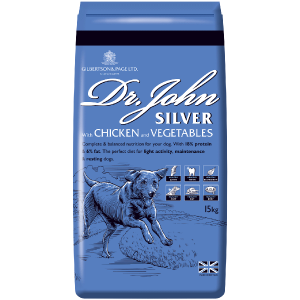 Recovering from operations, or long term illnesses should also be taken into account when considering diet, even in the case of standard operations like neutering or dental treatments. Assess how your dog is coping; whether there are problems with chewing after dental work (in which case soak the food for longer in warm water to soften it). If activity has to be restricted, then consider changing diet to a lighter, highly digestible food, as your dog will still want to have normal sized meals but won’t be using the same amount of energy as before. Joint supplements may be useful, for instance, an active ingredient in NZ green lipped mussel has been found to have an anti-inflammatory effect, and other ingredients are present that benefit joint health (We use a joint complex in many of our diets, ( Gilpa Kennel for instance). In some dogs, neutering can have a long term effect on metabolism slowing it so these dogs are prone to weight gain and will need to be fed a lighter or low fat diet. (try Dr. John Silver).
Recovering from operations, or long term illnesses should also be taken into account when considering diet, even in the case of standard operations like neutering or dental treatments. Assess how your dog is coping; whether there are problems with chewing after dental work (in which case soak the food for longer in warm water to soften it). If activity has to be restricted, then consider changing diet to a lighter, highly digestible food, as your dog will still want to have normal sized meals but won’t be using the same amount of energy as before. Joint supplements may be useful, for instance, an active ingredient in NZ green lipped mussel has been found to have an anti-inflammatory effect, and other ingredients are present that benefit joint health (We use a joint complex in many of our diets, ( Gilpa Kennel for instance). In some dogs, neutering can have a long term effect on metabolism slowing it so these dogs are prone to weight gain and will need to be fed a lighter or low fat diet. (try Dr. John Silver).
Digestive upsets are unfortunately common with dogs, partly due to their curiosity in trying all available food! It’s important to respond quickly to these so that long term effects and food allergies are avoided. Typical advice from vets is to stop feeding adult dogs for 24 hours when they show signs of diarrhoea and then to slowly re-introduce a light, highly digestible diet to them. This can be a home cooked meal of poached skinless chicken breast with boiled white rice or alternatively plainly cooked white fish (boneless and skinless) or a complete food designed for sensitive stomachs (Dr John Hypoallergenic Chicken with oats for example). It is also worth contacting your vet with regard to digestive upsets, certainly the first 2-3 times this occurs, until you feel confident of knowing whether the attack is severe or unusual requiring veterinary attention or can be managed at home.
Food allergies in dogs under a year of age have been shown to be more persistent and severe than allergies that develop later in life. Therefore, it makes sense to monitor your dog carefully over this period and make any change in diet or treat very gradual to ensure you give your dog the best chance of avoiding attacks. The main change at this age will be from a growth diet to an adult food, so early research into finding the right diet for your dog as an adult is recommended.
Overall with adults, keeping a close eye on condition, behaviour, activity and health will usually ensure you pick up on any detrimental changes early and can then make the right choice of diet to suit.
PERFORMANCE & HARD WORKING DOGS
It’s worth considering working dogs separately to pets with regard to dietary requirements. Rather like human athletes, they can have a variety of different additional needs, dependant on the work they carry out or sport they engage in, however, some general principles apply with working dogs.
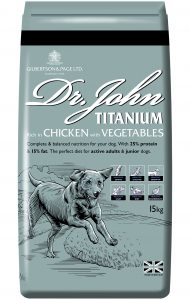 Firstly more energy: working or sporting dogs are likely to need either a higher energy diet like Dr. John Titanium or a good active maintenance diet like Dr. John Gold, with enough energy for activity, protein for growth, maintenance and repair of tissues and essential fats for condition and additional energy. Start by feeding towards the upper end of the recommended feeding requirements to get the right level to maintain condition in your dog. Feeding twice a day is ideal for most dogs, however, it needs to be at appropriate times for a working dog so they rest after eating to encourage good digestion before starting a period of work.
Firstly more energy: working or sporting dogs are likely to need either a higher energy diet like Dr. John Titanium or a good active maintenance diet like Dr. John Gold, with enough energy for activity, protein for growth, maintenance and repair of tissues and essential fats for condition and additional energy. Start by feeding towards the upper end of the recommended feeding requirements to get the right level to maintain condition in your dog. Feeding twice a day is ideal for most dogs, however, it needs to be at appropriate times for a working dog so they rest after eating to encourage good digestion before starting a period of work.
Consider their levels and type of activity: If they are active throughout the day, i.e. a working sheepdog, or police detection dog, then stamina is important and slow-releasing complex carbohydrates (whole grain cereals) can provide them with the energy they need to take them through their working day.
Sporting dogs like Spaniels and Labradors used in shoots and trials, will need higher levels of energy for short bursts of activity, they will also need good concentration and eye sight for retrieval, so a highly active diet like Dr. John Titanium will give them the additional energy and nutrient levels they need along with a joint supplement to keep their active joints supported and in good health.
At the other end of the spectrum, the racing Greyhound has been designed for immense speed, sprinting over short distances and extraordinary concentration on the lure but then followed by collapsing on the sofa at the end of the day. Racing Greyhounds need small biscuit based diets to suit their mouth size (like Dr John Grain Free) and the diet must be low bulk, high digestibility and high fat and with a good level of protein (24-25%) as this improves race times and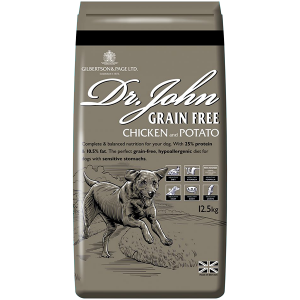 prevents the development of anaemia which they are prone to. The mineral content of the diet is particularly important for greyhounds as they need up to 2-3 times the normal levels of a sedentary dog, to cope with the stress of racing. A supplement during race season may be needed to keep the Greyhound in good health.
prevents the development of anaemia which they are prone to. The mineral content of the diet is particularly important for greyhounds as they need up to 2-3 times the normal levels of a sedentary dog, to cope with the stress of racing. A supplement during race season may be needed to keep the Greyhound in good health.
Changing the diet: working dogs will need to change diets just like pet dogs at different times in their life, so finding the right growth, adult and senior diets is important. Making sure the changes are not over periods of stress or high work is ideal and will help to minimise any digestive upsets as quickly as possible to ensure there is no loss of condition to the dog. These dogs will show illness quicker so keeping a close eye on general health should help to pick out symptoms early.
With all working and sporting breeds, their diet needs to be reviewed regularly to make sure they are in optimum condition and enjoying their food. When they are not working or racing it is advisable to move them to a lighter, lower fat maintenance diet so they don’t notice that their meals are smaller and they then will not gain unwanted weight in the resting periods. On retirement, continue to feed them a good, digestible, maintenance diet, preferably with a joint health supplement (for instance Gilpa Kennel) to ease them through their senior years.
REPRODUCTION – THE HEAT CYCLE
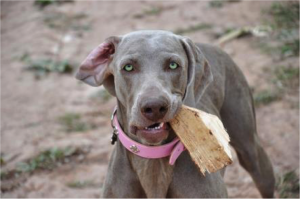 The female heat cycle or season occurs twice per year and starts at between 5-8 months of age. The first time can be quite stressful, as apart from the mess, you will also have to contend with the risk of an unwanted pregnancy if you are not vigilant in keeping male dogs away from her. It is particularly important to avoid the risk of pregnancy in the first season as she will not be fully grown or developed which can run the risk of dystocia (difficulty during whelping, that often necessitates a caesarean) and she is not likely to be an attentive mother.
The female heat cycle or season occurs twice per year and starts at between 5-8 months of age. The first time can be quite stressful, as apart from the mess, you will also have to contend with the risk of an unwanted pregnancy if you are not vigilant in keeping male dogs away from her. It is particularly important to avoid the risk of pregnancy in the first season as she will not be fully grown or developed which can run the risk of dystocia (difficulty during whelping, that often necessitates a caesarean) and she is not likely to be an attentive mother.
The cycle lasts between 14 and 28 days and begins from when bleeding is first noticed. If you intend to breed, then find out as much as possible about the subject beforehand, your breeder, vet and the Kennel Club are all good sources of information to ensure the best outcome.
Normal symptoms & what to watch out for
Some females will have a depressed appetite and may even be sick during their season. Keep a check on this as this can be similar to pyometra which is an infection of the uterus which can occur 2-8 weeks after the heat cycle finishes (typically in older females). Unusual symptoms to watch for are lethargy, thirst, bad smell, increased urination and loss of appetite. As the infection progresses it is followed by abdominal bloating and pus discharge from the vulva. It is important to get veterinary attention as soon as possible if you are concerned, as this can be a life-threatening infection.
Another common complication is false pregnancy. This can occur soon after the heat cycle and mimic all the signs of pregnancy. Typically symptoms will last for a month or so before subsiding naturally. Getting a vet’s diagnosis can be helpful in ruling out other possible causes.
If you are not planning to breed, then there are a number of good reasons to neuter as it can prevent cancers and infections as well as the risk of unwanted pregnancies. The optimum time for this surgery is approximately 6-12 weeks after the bleeding stops, as this will be in the middle of her next reproductive cycle.
If you keep an entire (un-neutered) male dog at home as well, then you may find it necessary to make arrangements for them to have a holiday away from home during the season. This should be for at least 28 days from the date the bleeding was first noticed.
Feeding during a season
It can be quite common to see a little weight gain during this period if you are restricting walks and access to unwanted male dogs. Some go off their food a little, but have this checked by your vet if it is more than one or two meals, as it could be a sign of illness. Continue to feed the same amount of the maintenance diet (or junior diet if it is the first season) until the season is over and then adjust the amount so to gain or lose weight if need be.
FEEDING DURING PREGNANCY
What to expect during pregnancy, puppy growth and symptoms
Days 1-7: Fertilisation, at this stage you may notice mild morning sickness and personality changes in the female. Watch for any signs of infection from breeding.
Days 7 -14: If fertilisation was successful, the embryo cells will begin to rapidly divide to 4 and upwards to 64 cells. At this time the embryos enter the uterus.
Days 14- 21: Sometime between day 18 and 20, the embryos will implant in the uterus.
Days 21- 28: The fetuses will grow from 5-10mm to 14-16mm, their faces take shape and their eyes and spinal cords develop. A vet will be able to palpate and possibly detect pregnancy between days 27 and 31.
Days 28 – 35: At this time the fetuses begin to resemble dogs with developing toes, whiskers and claws. They can be identified as male and female at this point and their eyes will now close (and remain closed until the pups reach until about 10 days old or so.) At this stage they become more resistant to development problems. In the mother, her weight will begin to increase, and swelling will begin to be noticeable.
Days 35-42: Puppies become coloured (skin pigment develops) and the mother’s stomach continues to swell.
Days 42- 49: The developing puppies continue to grow. The mother will start shedding her stomach hair.
Day 49- 57: When the mother is resting you will be able on occasion to see and feel the pups moving. Pups can be born at any time now, but keeping them in for another week is much healthier, so avoid rough play. Some dams can get milk (colostrum) as early as day 45, but normally it is later on.
Days 57-65: Nesting behaviour may start or she may seek out a quiet area. Start taking her temperature three to five times a day as it will peak as she begins to give birth.
It’s worth getting your vet to advise you on the birth process with puppies and what might go wrong if this is the first litter you have overseen. Reference books can also provide additional information and reassurance on the day. Finally, research whelping kits (ID collar bands, UV lamps, heat pads and bitch milk replacer for instance) early on to ensure you have everything to hand when needed.
WHAT TO FEED DURING PREGNANCY
 As an overall guide feeding a palatable, balanced adult maintenance diet during this period is ideal in a normal healthy pregnancy, and there should be no need to supplement. All of our adult diets are suitable for the requirements of pregnancy, however, Gilpa Trinkets, Dr. John Titanium are ideal for particularly small females or those likely to have a large litter as these diets have higher energy and protein content which will help with the additional requirements of pregnancy and enhance milk yield.
As an overall guide feeding a palatable, balanced adult maintenance diet during this period is ideal in a normal healthy pregnancy, and there should be no need to supplement. All of our adult diets are suitable for the requirements of pregnancy, however, Gilpa Trinkets, Dr. John Titanium are ideal for particularly small females or those likely to have a large litter as these diets have higher energy and protein content which will help with the additional requirements of pregnancy and enhance milk yield.
If you decide to change her diet, it’s best to do so very gradually and not at critical times such as when she is due to give birth or weaning. Some breeders find that feeding free choice throughout the pregnancy is beneficial so they become used to the regime, but this is best only for non-greedy dogs. You may find that towards the end of pregnancy and throughout lactation the increased ration is best fed in more frequent meals or free choice. Act quickly on any symptoms or signs of illness and contact your vet as soon as you have any concerns, to avoid any losses.
FEEDING AT MATING
Whilst there are no special dietary requirements for mating, it is sensible to make final adjustments to feeding rates to ensure she is in the best of condition and not overweight. It is advisable to record the weight at mating so you can aim to feed her back up to this weight after weaning has been completed.
FEEDING THROUGHOUT PREGNANCY
The duration of pregnancy in dogs can range from anything between 57 – 69 days. Feeding well throughout this period should ensure a successful outcome and healthy well-fed pups. For the first 35 days there is no need to increase the amount to feed, simply feed as normal and monitor appetite, digestion and condition. You may notice that during week 4 and 5 of pregnancy she loses her appetite, which in most cases is entirely normal and indicative of pregnancy. However, in the last third of the pregnancy period she will need to have her food increased by approximately 10% a week so that when she is ready to give birth she is having 1.5 times her maintenance amount. As the pups increase in size in her, her stomach capacity is reduced so feed her little and often or through free choice feeding.
FEEDING FOR LACTATION
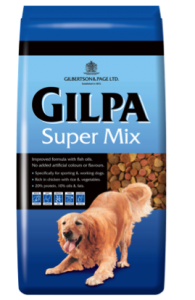 This is the most demanding part for the new mother as now she needs to produce nutrient-rich milk for in some cases very large litters which will grow incredibly quickly. The amount of food she needs to manage this, at the absolute peak of lactation (week 3-6 after birth) can reach 4 times her normal maintenance amount. A good starting point to work out how much food she will need is to calculate the maintenance amount of food she has, plus 25% of this amount for each puppy.
This is the most demanding part for the new mother as now she needs to produce nutrient-rich milk for in some cases very large litters which will grow incredibly quickly. The amount of food she needs to manage this, at the absolute peak of lactation (week 3-6 after birth) can reach 4 times her normal maintenance amount. A good starting point to work out how much food she will need is to calculate the maintenance amount of food she has, plus 25% of this amount for each puppy.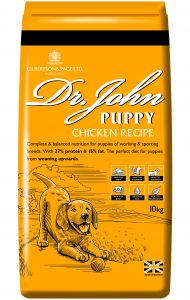
To consume sufficient food, she will need food offered frequently and made palatable to her. If she is showing signs of lack of appetite, you can try soaking the food in warm water or a little gravy to make it more palatable. The object is to try and maintain her condition, though there is often an inevitable loss with a very large litter that will need to be built up again after the pups have left. Introducing a puppy food (in porridge consistency) as a supplement to her milk to the pups at 4 weeks of age can help with large litters, especially if some are struggling to gain weight.
She may seem to be thirstier than normal due to all the milk production, for example, a Labrador at peak lactation may produce as much as 1.5 litres of milk so her water requirements will increase by almost this amount. At weaning (5 to 8 weeks after whelping) reducing her food gradually will help to naturally reduce milk supply which together with the removal of the puppies during the daytime will aid the weaning process. By this point, the puppies should be eating puppy food in sufficient quantities for successful growth.
OVERWEIGHT DOGS OR THOSE PRONE TO WEIGHT GAIN
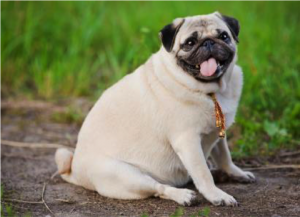 Just like humans, some dogs are prone to gain weight if allowed. Sometimes this can be due to restricted exercise, hormonal changes or successful scavenging techniques. In addition, some breeds are more likely to gain weight than others – Labradors, Pugs, Cocker Spaniels, Dachshunds etc. The pet food manufacturers association (PFMA) suggests that in the UK today up to half of dogs seen by vets are overweight. This has terrible effects on dogs in restricting their life, they are often unfit, suffer from arthritis and will live up to two years less than a healthy weight dog. Other obesity-related diseases that are often seen in overweight dogs are diabetes, kidney disease, hypertension and respiratory problems.
Just like humans, some dogs are prone to gain weight if allowed. Sometimes this can be due to restricted exercise, hormonal changes or successful scavenging techniques. In addition, some breeds are more likely to gain weight than others – Labradors, Pugs, Cocker Spaniels, Dachshunds etc. The pet food manufacturers association (PFMA) suggests that in the UK today up to half of dogs seen by vets are overweight. This has terrible effects on dogs in restricting their life, they are often unfit, suffer from arthritis and will live up to two years less than a healthy weight dog. Other obesity-related diseases that are often seen in overweight dogs are diabetes, kidney disease, hypertension and respiratory problems.
Prevention is the best plan with obesity, by regularly weighing your dog on every visit to the vet (or many big pet shops also have bodyweight scales also) you can keep a check on your dog’s weight. Body condition charts can be used if you have a good critical eye, but it is not easy to assess long haired breeds. Weighing each bowl of food that you put down is the ideal method of ensuring that you are feeding the correct amount. Measuring cups can be a useful aid but if more than one person prepares the meal it is possible for inaccuracies to creep in.
Treats are an area of concern, often dog treats are often high in fat, sugar and salt, so restrict feeding these. Giving human food as treats is also not advisable, obvious pitfalls are feeding from the fridge, the table and allowing guests to feed your dog their food, all of these can cause bad behavioural habits as well as making it very difficult to assess your dog’s daily intake. There are a number of human foods which are unsuitable or even poisonous for dogs too, so it is better to keep your dog on a strict planned diet with weighed amounts of dog food.
If your dog needs to lose weight, then approach this on three levels:
- Increased activity (with veterinary advice if your dog is suffering breathing or joint problems).
- Change of diet to a low fat, light diet using weighed amounts.
- Complete exclusion of high calorie treats.
It is important that each of these changes happens gradually, so the dog does not become distressed, hungry or stiff from excessive walking. Keep monitoring the weight loss by regular weighing sessions, as the amount fed will need to be decreased as your dog loses weight.
SENIOR DOGS
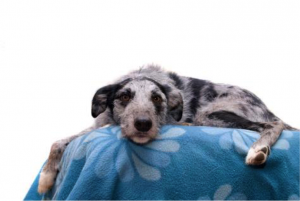 Generally, after the age of seven most dogs will start to show some signs of aging. They may just be a little slower on their walks, sleep a little deeper at night and need more reassurance and affection from you, but it can also be the start of some debilitating illnesses like arthritis, diabetes and kidney disease.
Generally, after the age of seven most dogs will start to show some signs of aging. They may just be a little slower on their walks, sleep a little deeper at night and need more reassurance and affection from you, but it can also be the start of some debilitating illnesses like arthritis, diabetes and kidney disease.
As your dog ages, there is a general decrease in energy needs, firstly due to a reduction in physiological needs but also due to reduced activity. Therefore, it makes sense to keep a close eye on any weight fluctuations and reduce the amount fed as required. On a physiological level, ageing can lead to a number of changes in your dog’s body, seniors often have lower glucose tolerance, less lean body mass, and reduced function from their kidneys (reduced kidney blood flow and glomerular filtration rate), their immune function, hormone secretion and response, brain and enzyme activity and mineral uptake/homeostasis can all be reduced too, making them more vulnerable to illness, environmental changes and digestion and absorption issues.

The most important thing is to recognise when these symptoms and factors appear. This can vary greatly between breeds, breed size and even individually as well, so it is often difficult to predict when a different diet will be required. The situation is further complicated as some symptoms may disappear as the dog ages. A recent study that showed that some 30% of dogs presented to vets were overweight at 6-8 years of age, but by 12 years of age a similar sample showed only 5% to fit this category while 16% were underweight. So, not all senior dogs should be fed a light diet.
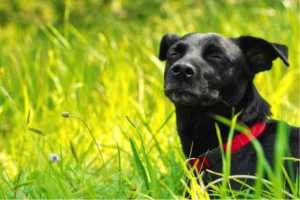 The protein requirement of the senior dog is the subject of much debate amongst nutritionists. Current thinking is that the requirement remains stable with ageing in the absence of disease. However, it is also believed that the reduction of protein in the management of certain illnesses, can be of benefit in senior dogs. Whether high levels of protein cause or increase the risk of that condition in the ageing dog is not known or accepted. Severely reduced protein levels are also not necessarily healthy for a dog, extremely low levels can lead to deficiencies in wound healing, immune function and cell replacement. Therefore the best answer is to feed good quality protein (animal sources like chicken or lamb are perfect) but not at high levels.
The protein requirement of the senior dog is the subject of much debate amongst nutritionists. Current thinking is that the requirement remains stable with ageing in the absence of disease. However, it is also believed that the reduction of protein in the management of certain illnesses, can be of benefit in senior dogs. Whether high levels of protein cause or increase the risk of that condition in the ageing dog is not known or accepted. Severely reduced protein levels are also not necessarily healthy for a dog, extremely low levels can lead to deficiencies in wound healing, immune function and cell replacement. Therefore the best answer is to feed good quality protein (animal sources like chicken or lamb are perfect) but not at high levels.
Low phosphorus diets are often advised for older dogs. They can delay the progression of renal failure and accompanying symptoms, but seek veterinary advice before deciding to feed one, as it is not necessary for all dogs.

